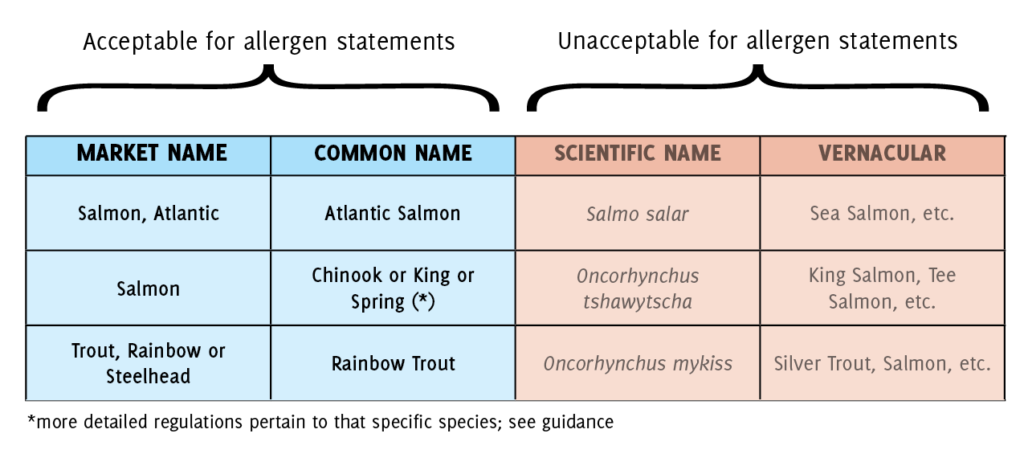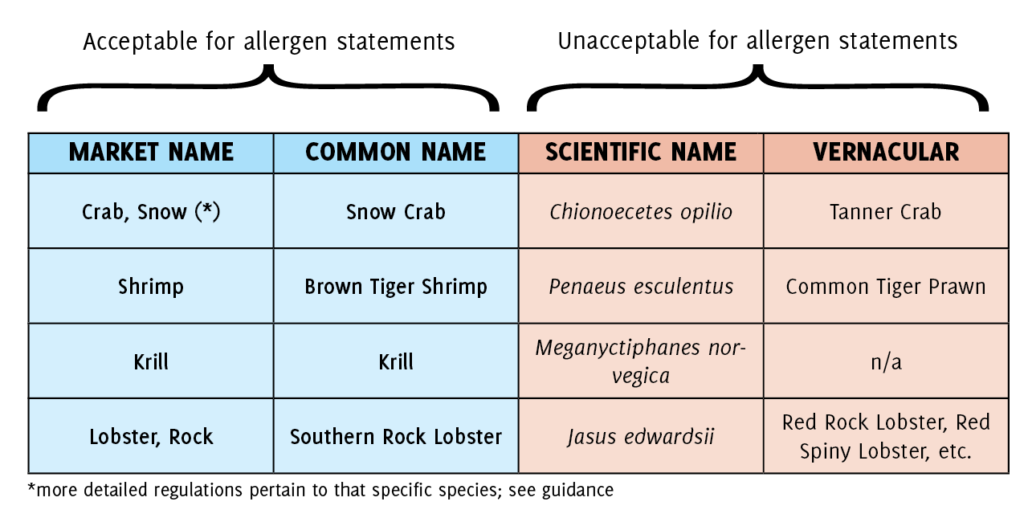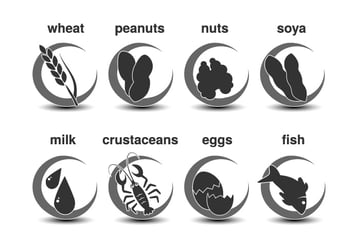The Food Allergen Labeling and Consumer Protection Act of 2004 (FALCPA) mandates that packaged food items must declare, in plain language, the presence of any major food allergens on the product packaging.
 This list, historically referred to as the “Big 8” Allergens, was expanded on April 23, 2021, when the Food Allergy Safety, Treatment, Education, and Research (FASTER) Act was signed into law, declaring Sesame as the 9th major food allergen recognized by the United States.
This list, historically referred to as the “Big 8” Allergens, was expanded on April 23, 2021, when the Food Allergy Safety, Treatment, Education, and Research (FASTER) Act was signed into law, declaring Sesame as the 9th major food allergen recognized by the United States.
The law defines a major food allergen to mean any one of the following nine foods or food groups (or an ingredient that contains their proteins): Milk, Egg, Fish, Crustacean shellfish, Tree nuts, Wheat, Peanuts, Soybeans, and Sesame.
To comply with FALCPA requirements, food packages must display allergens using their common name and list them either:
- In a parenthetical directly after the name of the ingredient within the ingredient statement. Example: Peanut butter (peanuts), casein (milk), spice (sesame)…
Or
- In a separate “Contains” statement. Example: Contains peanuts, milk, and sesame.
Below we will discuss each of the U.S. allergens and their declaration requirements, including allowable synonyms and specific types/species.
Single-ingredient products, or products containing milk or milk protein, must include “milk” in the Contains statement or ingredient statement. No synonyms apply.
Egg
Single-ingredient products, or products containing egg or egg protein, must include “egg” in the Contains statement or ingredient statement. No synonyms apply.
Seafood (Fish & Crustacean Shellfish)
For Fish and Crustacean Shellfish, you must declare the specific species of seafood by using either the common name or acceptable market name. The Scientific name (the Latin name for the genus and species of the fish) or Vernacular name is NOT acceptable.
When determining how to appropriately label a seafood allergen, you can check The Seafood List and search by Market Name, Common Name, and/or Scientific Name. There are nearly 2,000 records of fish and shellfish in this list, which is updated regularly. An asterisk (*) next to the Market Name indicates that a regulation pertains to that species. Additional information can be found in the Seafood List Guidance on the FDA’s website.
Please note: Some records may display the vernacular names for species. This is for cross-reference ONLY. The scientific and vernacular names are not acceptable to list on the product package.
Single-ingredient products, or products containing fish or fish protein, must declare the specific species of fish (e.g., bass, flounder, or cod) in the Contains statement or ingredient statement. Here is what you’ll see for salmon:

This table shows examples of acceptable market names and common names when listing fish species in an allergen statement.
Single-ingredient products, or products containing crustacean shellfish or shellfish protein, must declare the specific species of crustacean shellfish (crab, lobster, or shrimp) in the Contains statement or ingredient statement. Exemptions: Molluscan shellfish (such as oysters, clams, mussels, or scallops) are not part of the Crustacean shellfish grouping. Crustacean shellfish include the following examples:

Single-ingredient products, or products containing tree nuts or protein from a tree nut, must declare the specific type of tree nut (e.g., almonds, pecans, or walnuts) in the Contains statement or ingredient statement. The common or usual name must be used (as opposed to its scientific name). Tree nuts may be expressed in either the singular or plural form (almond vs almonds). Here are the specific tree nut types:
- Almond
- Beech nut
- Brazil nut
- Butternut
- Cashew
- Chestnut (Chinese, American, European, Seguin)
- Chinquapin
- Coconut
- Filbert/Hazelnut
- Gingko nut
- Hickory nut
- Lichee nut
- Macadamia nut/Bush nut
- Pecan
- Pine nut/Pinon nut
- Pili nut
- Pistachio
- Sheanut
- Walnut (English, Persian, Black, Japanese,
California), Heartnut, Butternut
The term “wheat” means any species in the genus Triticum. Single-ingredient products, or products containing wheat or wheat protein, must include “wheat” in the Contains statement or ingredient statement (you don’t have to declare the specific genus). Wheat includes grains such as:
- Common wheat (Triticum aestivum L.)
- Durum wheat (Triticum durum Desf.)
- Club wheat (Triticum compactum Host.)
- Spelt (Triticum spelta L.)
- Semolina (Triticum durum Desf.)
- Einkorn (Triticum monococcum subsp. monococcum L.)
- Emmer (Triticum turgidum L. subsp. dicoccon (Schrank) Thell.)
- Khorasan wheat (Triticum polonicum L.)
- Triticale (x Triticosecale ssp. Wittm.)
Single-ingredient products, or products containing peanuts or peanut protein, must include “peanut” or “peanuts” in the Contains statement or ingredient statement. May be expressed in either the singular or plural form (e.g. peanut or peanuts).
Single-ingredient products, or products containing soybeans or soybean protein, must include “soybean” (or one of the approved synonyms) in the Contains statement or ingredient statement.
However, “Soybeans” should be used as the common or usual name to properly identify the ingredient for packaged foods using soybeans as an ingredient or as part of a multi-component ingredient (e.g., miso or tofu). The appropriate declaration would appear as such within the ingredients list: miso (fermented soybeans, salt, koji).
Synonyms: soybean, soy, and soya.
Single-ingredient products, or products containing sesame or sesame protein, must include “sesame” in the Contains statement or ingredient statement. No other synonyms apply.
How Can Genesis Foods Help?
Genesis Foods offers features to help with compliance. Check out these related resources:
- Tutorial: Adding Allergens to the Genesis R&D Database.
- Tutorial Best Practices for Using Genesis R&D to Declare Allergens and Create An Allergen Statement.
- Blog: Allergen Statement in Genesis R&D Foods.
To learn more, read this article Guidance for Industry: Questions and Answers Regarding Food Allergens (Edition 4) on the FDA’s website.
Tag(s):
Food Labeling
Other posts you might be interested in
View All Posts
Supplier Compliance
6 min read
| February 12, 2019
Food Allergen Labeling: Getting it Right Through Supply Chain Transparency
Read More
Food Labeling
18 min read
| October 8, 2021
How to Declare Sesame as an Allergen in Genesis R&D Foods
Read More
Food Industry
9 min read
| February 21, 2023



